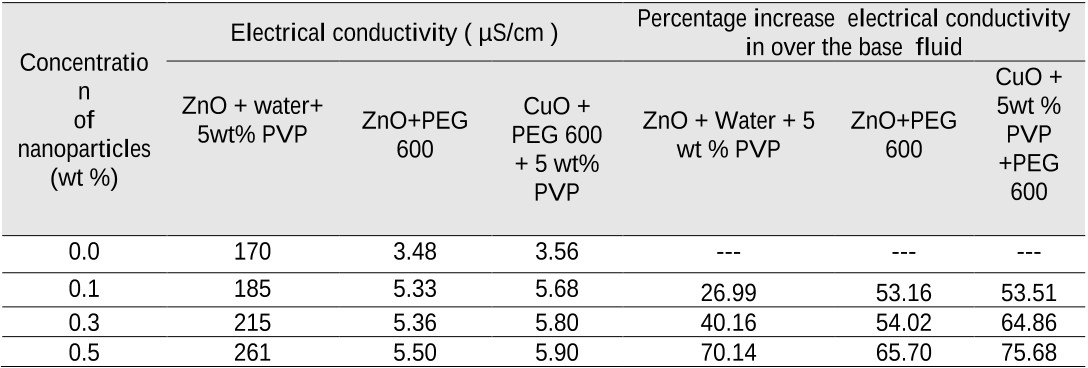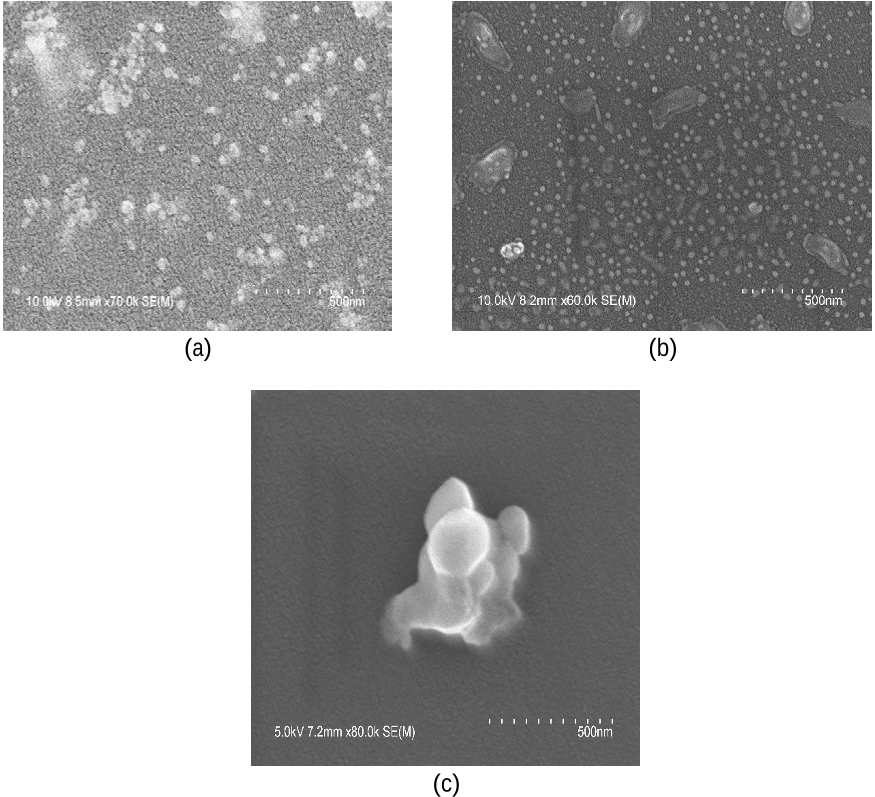
1
Research article
Investigations on the Thermal and Electrical Conductivity of Polyethylene
Glycol-based CuO and ZnO Nanofluids
Swaminathan Ponmani,
a,b
Pawan Gupta,
a
Prashant Jadhawar,
c
R. Nagarajan,
d
Jitendra Sangwai
a,*
a
Gas Hydrate and Flow Assurance Laboratory, Department of Ocean Engineering, Indian
Institute of Technology Madras, Chennai- 600036, Tamilnadu, India
b
Department of Petroleum Engineering, AMET University, kanathur, Chennai 603112
c
School of Engineering, University of Aberdeen, UK
d
Department of Chemical Engineering, Indian Institute of Technology Madras, Chennai- 600036,
Tamilnadu, India
*Corresponding Author:
Jitendra S. Sangwai
Email: jitendrasangwai@iitm.ac.in
Phone: +91-44-2257-4825
Fax: +91-44-2257-4802

2
Abstract
In this experimental work, three different types of nanofluids were evaluated for their
stability using dynamic light scattering (DLS) and particle morphological study using scanning
electron microscopy (SEM). The nanofluids used in this study are zinc oxide (ZnO) nanoparticle
in water and 5 wt% polyvinylpyrrolidone (PVP) as a dispersant, and ZnO with polyethylene glycol
(PEG 600) and CuO with PEG 600 with 5wt% PVP at different concentration of 0.1, 0.3 and
0.5wt %. Thermal and electrical conductivities were determined by KD-2 Pro
®
and PC 700
Eutech
®
. The result shows better enhancement in the thermal and electrical conductivity in the
ZnO+PVP+Water system, followed by the CuO+PVP+PEG and ZnO+PEG systems. The highest
percentage enhancement in thermal conductivity found to be 35.5 % of ZnO+ PVP+water systems.
The thermal conductivity results were compared with a theoretical model and show good
agreement with results predicted by the model. The proposed model of Nan et al. (1997) is based
on a hypothesis regarding the physical mechanism in heat transfer for nanofluids. This study is
expected to form the basis for the development of nanofluid-based technologies with PEG as the
primary additive in the upstream oil and gas industry especially in gas hydrates and drilling
technology.
Keywords: Electrical conductivity; Nanofluids; Stability; Thermal conductivity; Nan’s model.

3
1. Introduction
Nanofluids have shown various interesting properties, and the distinguishing features offer
exceptional potential for different industrial applications, such as electronic, transportation,
improve recovery in oil and gas well, industrial cooling applications, nuclear systems cooling, etc.
Nanofluids are essentially two-phase systems, viz., solid phase in the liquid phase. Several
industries are in need of a cooling medium to improve the heat transfer performance, and of new
technology to overcome persistent challenges. A solid has a higher thermal conductivity than a
liquid, and hence, to increase the thermal conductivity, nanosized particles suspended in a base
fluid, known as ‘nanofluids’, are used. Nanoparticles have good electrical, magnetic and optical
properties. Accordingly, the mechanism for thermal conductivity enhancement is believed to be
the responsible parameter for enhancing heat transfer in engineering applications. However, the
research on the electrical properties of the nanofluid is very rare. The factors responsible for
enhancing heat transfer of nanofluids are the types of nanoparticle, particle size, aggregation,
Brownian motion of the particles and temperature of the nanofluids. Various mechanisms and
models, based on various assumptions, have been recently developed for explaining the unusually
high thermal conductivity of nanofluids [1-3]. Two significant requirements for measuring the
thermal conductivity are preparation of a homogeneous mixture and long-term stability which can
withsatand the initial equilibrium conditions until measurement. The electrical conductivity of a
suspension depends on the background electrolyte, particle size, charge, and volume fraction [4-
6]. Choi and his group [7] were the first to report that the suspended particles in the base fluid can
significantly enhance the heat transfer and give rise to improvement in the heat exchange systems.
Yu et al. [8] studied the thermal conductivity of copper oxide (CuO) nanofluids with ethylene
glycol and polyvinylpyrrolidone (PVP) as dispersants. The results showed about 46%
enhancement in the thermal conductivity in about 0.5 vol% of particle concentration at 50
o
C, and

4
demonstrated that the temperature and Brownian motion of nanoparticles play an important role
in the thermal conductivity enhancement. Mehrali et al. [9] showed that by using graphene
nanoplatelets, a stable nanofluid with distilled water could be prepared without surfactant by
ultrasonic probe dispersion technique. The researchers showed about a 28% enhancement in
thermal conductivity and demonstrated that the stability of nanofluids found to be enhanced due
to ultrasonication. These nanofluids can act as an advanced heat transfer fluid in a medium
temperature applications in solar and heat exchangers. Xie et al. [10] conducted studies using
different nanoparticles, such as silicon carbide (SiC), zinc oxide (ZnO), carbon nanotubes (CNT)
and aluminum oxide (Al
2
O
3
) with base fluids, such as deionized water, glycerol, ethylene glycol
and the mixture of water and ethylene glycol. The results showed that the thermal conductivity
enhancement has been influenced by the volume fraction of the particle and due to temperature.
Fedele et al. [11] studied CuO, titanium oxide (TiO
2
) and single-walled carbon nanohorns
(SWCNHs) with water as a base fluid. They used polyethylene glycol (PEG) and sodium dodecyl
sulfate (SDS) as dispersing agents. They investigated three dispersion techniques, such as
sonification, high-pressure homogenization and ball milling for the formation of nanofluids. The
high-pressure homogenization method was found to yield better stability of the nanofluids.
Kole and Dey [12] prepared stable ZnO-ethylene glycol nanofluids by prolonged
sonification of >62 hours and showed that extended time for sonification gives better
fragmentation and dispersion of the particles. In their studies, they considered both temperature
and nanoparticle concentration for thermal conductivity enhancement. The results showed that
approximately 40% of thermal conductivity enhancement is achieved at 30
o
C and with 3.75vol%
of ZnO. Suganthi et al. [13] investigated a colloidal dispersion of ZnO-propylene glycol. Thermal
conductivity was measured in the temperature range of 10-60
0
C and for various aggregate sizes.

5
The researchers observed that the thermal conductivity enhancement depends on temperature and
that higher enhancement is possible at a lower temperature. The result shows that the temperature
and aggregation of particles are major factors in the formation of a solvation layer on the ZnO
nanoparticle surfaces. Jeong et al. [14] showed that for ZnO nanoparticles, the thermal
conductivity and viscosity enhancement depend on the particle shape. The researchers used
spherical and rectangular particles with concentration range of 0.05 to 5 vol%. The results show
about 12% and 18% enhancement in thermal conductivity, respectively, for spherical and
rectangular particles at 5vol%. Moattar and Cegincara [15] used PEG to prepare stable nanofluids
of ZnO which was later characterized using dynamic light scattering. They observed the effect of
ZnO nanoparticles concentration and temperature on the volumetric and transport properties of the
aqueous solution of PEG but did not report information on enhancement in the thermal and
electrical property. Ponmani et al. [5] studied experimentally the thermal and electrical
conductivity of ZnO and CuO nanofluids in xanthan gum. They observed an approximately 25 and
50 % enhancement in thermal and electrical conductivity, respectively. White et al. [16]
investigated the electrical conductivity of propylene glycol-based ZnO nanofluids. The result
showed that a higher volume fraction of the particle gives better enhancement in electrical
conductivity. They observed that for about 7 % volume fraction of nanoparticles, electrical
conductivity showed up to 100-fold increase over the base fluid. Kim et al. [17] prepared stable
nanofluids using aluminum oxide, zinc oxide and titanium oxide nanoparticles with water and
ethylene glycol as a base. They showed that the enhancement in the thermal conductivity increases
linearly in lesser size of the particles when suspended in the base fluids. Khedkar et al. [18]
investigated the thermal conductivity of CuO nanofluids in monoethylene glycol and water. The
results show that the enhancement in thermal conductivity is due to the concentration of





